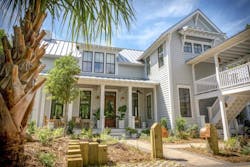5 Products to Improve Fire Prevention
There are five classes of fire and each presents a significant threat to any home, regardless of its build (though, some types of fires are more common than others). Still, while a home may never be totally fireproof, builders and remodelers can help homeowners prevent and limit the potential threat of and, furthermore, damage from home fires by using materials that resist heat and combustion.
It should go without saying that preventing loss of life is the single greatest reason to build homes to, as much as possible, resist fire. That being said, there is also a substantial financial incentive.
On the low end, fire recovery costs average in the thousands, according to Fixr, a company that specializes in home repair cost analysis. On the high end, the average cost to a homeowner can be upwards of $50,000 to recover from a fire (assuming the home is recoverable at all). Other analyses suggest a homeowner may end up paying as much as $150,000 in restoration costs.
Of the factors contributing to the likelihood of a future home fire (and its potential impact) the biggest effect builders and remodelers can have is in their material selections. There are myriad materials that provide varying levels of fire resistance and protection, and while we can’t catalog all within this article, we have provided below a selection of such materials to help professionals in their future decision making.
Leviton Outlet Branch Circuit AFCI Receptacles
These outlets from Leviton are designed with smart technology aimed at reducing the risk of arc-faults, “an unintentional arcing condition in a circuit” that “can occur anywhere in a home’s electrical system,” according to the company. Arc-faults can result in extremely high temperatures and the subsequent combustion of surrounding materials. The Outlet Branch Circuit AFCI Receptacles minimize the threat of arc-faults by finding and disrupting them. According to Leviton, the devices “are designed to identify potentially dangerous arc-faults and respond by interrupting power to help prevent an electrical fire.”
Sun FireDefense SPF3000
SPF3000 from Sun FireDefense is a patented coating designed for application on home exteriors in wildfire-prone areas to help reduce and even prevent combustion. According to the product’s patent, “when heated, the fire prevention coating formula forms a thick, stable, passivating oxide layer protecting surfaces from further reaction.” The company says that the formula can be applied to a number of materials, including “wood, polymers, metals, fabrics, fiberglass, and plastics,” and has been tested by the “U.S. Department of Energy, Environmental Consulting, Inc., and NTS Laboratories, Inc.”
James Hardie Fiber Cement Products
James Hardie’s fiber cement products, which range from siding to shingles and more, are non-combustible, which means they “will not ignite when exposed to a direct flame, nor will it contribute fuel to a fire,” according to the company. Furthermore, Hardie’s fiber cement products have a Class A fire rating when tested in accordance with ASTM E84, the best rating a product can receive. According to the Flame Spread Index, which measures how fast and far a flame can spread over a certain material, fiber cement was one of few materials to score a perfect ‘0.’
Forest Products Supply Co. Pyro-Guard
Fire-treated wood products, like Pyro-Guard lumber, are designed to resist combustion and minimize the threat of home fires overall. Pyro-Guard specifically is treated with fire retardant that when exposed to fire will produce non-combustible gas and water vapors, which result in the formation of a char membrane that serves to not only minimize the risk of combustion but to also protect the wood’s ultimate integrity. According to Forest Products Supply Co., because of the product’s properties, “fire damages and repair costs are minimized, resulting in reduced insurance rates.”
CertainTeed Type X Drywall
Most drywall is flame resistant to some degree, but CertainTeed’s Type X interior gypsum board is specifically designed to improve those characteristics. Type X features a “specially formulated core providing fire resistance ratings when used in tested assemblies.” When tested in accordance with ASTM E84, the product received a Flame Spread rating of 15 and a Smoke Developed rating of 0. Type X also has a fire rating up to four hours, according to the company,





